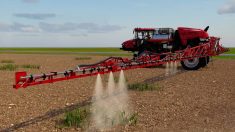There is good news and bad news in the recent data released from the Beef Information Centre’s research into consumer preferences for beef.
The good news is, the vast majority of consumers likes to eat beef. Ninety-six per cent of Canadian households and 93 per cent of individuals consume beef, which places its popularity close to that of chicken.
What that data doesn’t say is how much or how often they are eating beef products. Other research suggests beef consumption is losing ground to poultry, simply because it is more versatile and perceived to be easier to prepare.
Read Also

Farm equipment sales sector sees significant structural changes
Farming equipment sales have been declining for a number of years now, and one industry professional believes structural changes in the industry are needed to curb that trend.
But only six per cent of the population is actively trying to reduce or eliminate meat from their diets.
When consumers were asked what was paramount in deciding whether to buy beef out of a list of four concerns, 70 per cent of respondents ranked “healthfulness” as the top one or two priorities, 64 per cent said safety, 28 per cent said animal welfare, and 22 per cent environmental impact.
While only 23 per cent of respondents mentioned animal welfare concerns of that number, 35 per cent expressed concern about how animals are treated in the process of raising cattle, and 28 per cent specifically raised concerns about their treatment at slaughter.
That’s bad news. Why?
Industry leaders are in the habit of responding to concerns about the healthfulness of beef, the ways in which it is raised, or the manner in which it is processed as shenanigans of people who want everyone to stop eating meat.
But only six per cent of the population falls into that category. The remainder of the people raising concerns are this industry’s customers. As such, they can’t be ignored.
BIC spokesman Ron Glaser pointed out, “Overwhelmingly, it’s about health and nutrition. Production-related issues such as animal welfare and the environment are not the primary concern.”
Even so, animal welfare and environmental issues are cited by 28 per cent and 22 per cent of respondents. What business can expect to tune out a quarter of its customer base and expect to remain viable?
Good reputation
Thankfully, cattle producers have a relatively good reputation – as perceived by the public – on the animal welfare and environmental management fronts. The animals in this production system are associated with grazing on the open range rather than confinement in gestation stalls and battery cages.
As well, the industry is in the process of reviewing and updating its code of practice, which should help it stay abreast of society’s changing sensitivities. Producers need to take these guidelines seriously and use their application as a proactive way of staving off any critics.
Although cited by the greenhouse gas scrutinizers for phenomena such as bovine belching, the cow-calf industry harvests perennial forages and converts them into edible protein. Much of this takes place on land that has little alternative value in agriculture.
The story on the nutritional front is less clear.
Nutritional research of late has strongly encouraged consumers to eat less red meat. Per capita consumption trends in the U.S. suggest they are listening. Currently at 58 pounds per person in the U.S., that’s down from an all-time high 94 pounds per person in 1976. Some pundits are predicting it could drop to 55 pounds within the next few years. Canadian consumption is slightly lower, but follows the same trend.
So while it seems people are continuing to eat beef, they are eating smaller portions.
That’s bad news for an industry that is continuing to increase the size of the carcasses. Industry analysts have noted carcass weights and sizes have been getting larger – by as much as 175 pounds since the mid-1970s. The average carcass size is now 900 pounds per slaughtered animal, a brute that yields rib-eye cuts 18 to 20 inches in size.
As was pointed out at the recent Canadian Cattlemen’s Association meeting, a 12-ounce serving from a 20-square-inch rib-eye would be a quarter inch thick. Health professionals and dietitians are suggesting a four-ounce portion is more desirable.
If the top-of-mind issue for consumers when considering beef is the healthfulness of the product, the industry needs to get on board.
Industry insiders suggest the reason beef carcasses continue to get larger is because the primary producers are too busy trying to stay afloat to focus on quality instead of quantity. The focus at the producer level is on the packer, not the consumer, and on the rate of gain rather than end-use characteristics.
It’s one thing to promote traceability and national identification programs as a means of delivering market signals back to the farm gate. But unless those signals are accompanied by a bigger share of the value chain, the gap between what the consumer wants and what the industry delivers will continue to grow.
———
While it seems people are continuing to eat beef, they are eating smaller portions.















